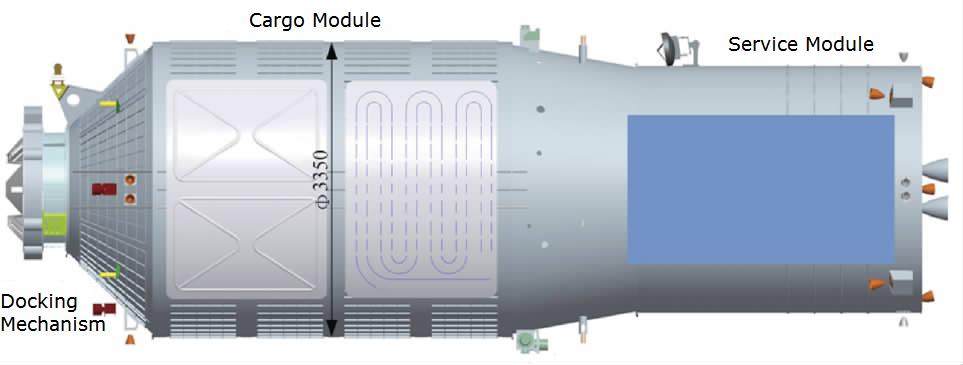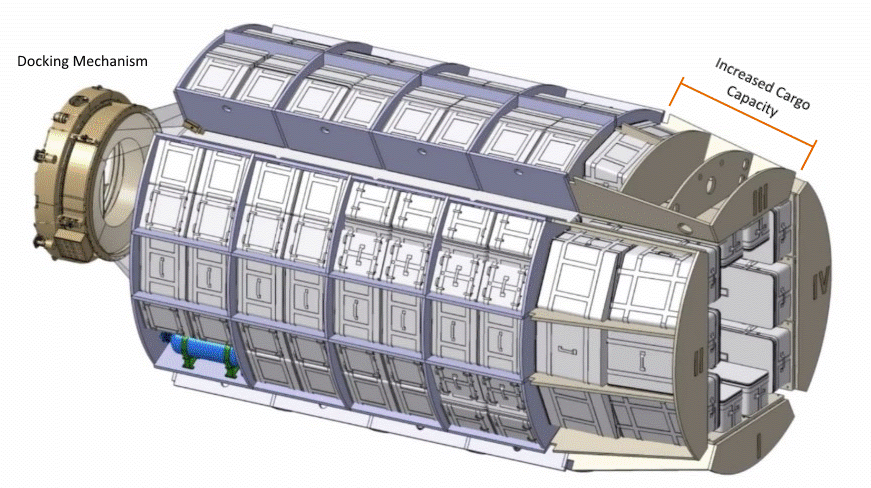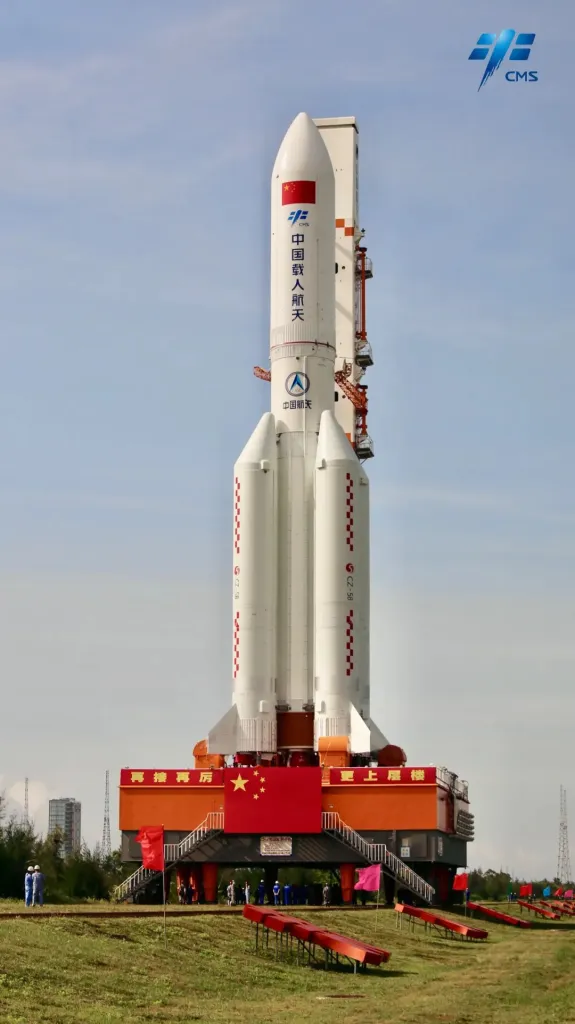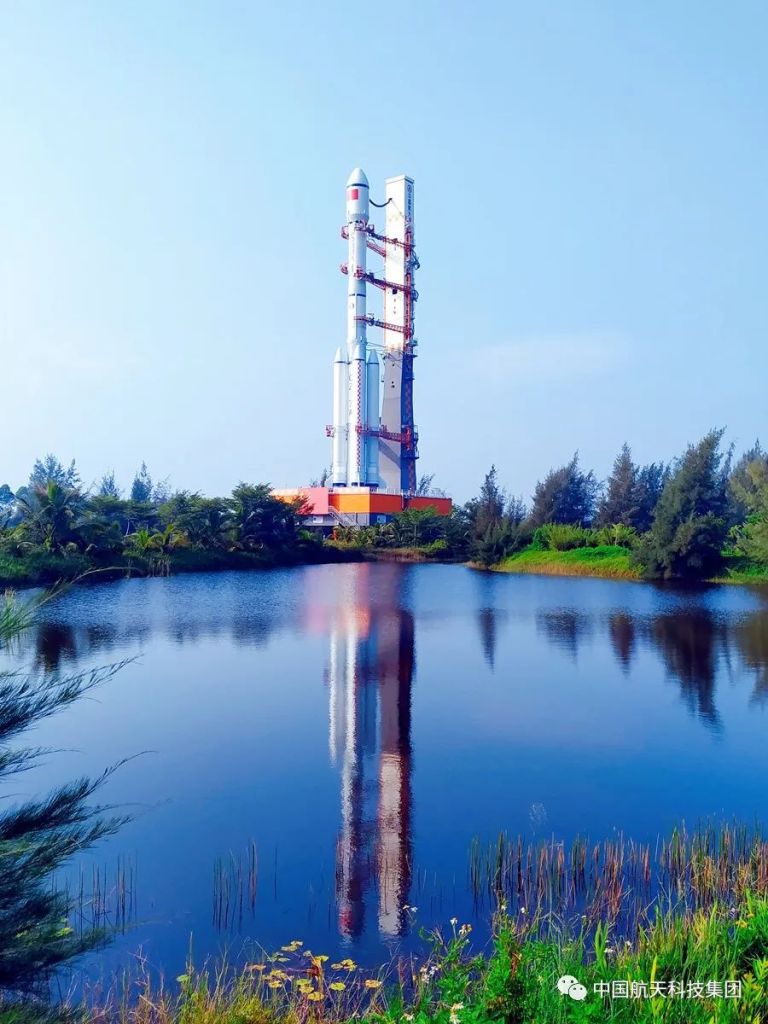Featured image credit: Xinhua
Lift-off Time | May 10, 2023 – 13:22:44 UTC — 21:22:44 BJT |
|---|---|
Mission Name | Tianzhou-6 (TZ-6), a resupply mission supporting Tiangong, the China Space Station (CSS) |
Launch Provider | China Aerospace Science and Technology Corporation (CASC) |
Customer | China Manned Space Agency (CMSA) |
Rocket | Long March 7 Y7 (CZ-7 Y7) |
Launch Location | LC-201, Wenchang Space Launch Site, China |
Payload mass | About 14,000 kg (~31,100 lb) |
Where is the satellite going? | A circular low-Earth orbit (LEO) at an altitude of 389.4 km (~242 mi) and an inclination of 41.48 degrees; initially, probably an elliptical orbit of ~200×420 km (~124×260 mi) x 41.84° |
Will they be attempting to recover the first stage? | No, the Long March 7 is not capable of stage recovery |
Where will the first stage land? | It will crash into the South China Sea |
Will they be attempting to recover the fairings? | No, the Long March 7 is not capable of fairing recovery |
Are these fairings new? | Yes |
This will be the: | –67th orbital launch attempt of 2023 –18th Chinese launch of 2023 –12th launch of a rocket of the Long March 7 family overall –2nd launch of a rocket of the Long March 7 family of 2023 –7th launch of the Long March 7 overall –1st launch of the Long March 7 of 2023 |
Where to watch | Official livestream |
What’s This All Mean?
The China Aerospace Science and Technology Corporation (CASC) — the main contractor working in the Chinese space program — will launch the Tianzhou-6 mission for the China Manned Space Agency (CMSA) aboard the Long March 7 rocket with serial number Y7. Lifting off from Wenchang, at Hainan Island in China, the launcher will inject the cargo spacecraft into an initial orbit. From there, the Tianzhou capsule will raise its orbit to meet that of the China Space Station (CSS), Tiangong. It will dock to this station, in order for the taikonauts — Chinese astronauts — to gain access to the transported supplies, i.e. food, experiments, consumables, hardware.
What Is The Tianzhou-6 Mission?
Chinese missions such as Tianzhou-6 are logistics flights made by such spacecraft to Tiangong. Through them, the China Manned Space (CMS) program is able to send supplies to the orbiting lab and its crew. Similarly, this is what happens with commercial resupply missions for NASA — using Dragons or Cygnuses — or Progress missions from Roscosmos. All of them play their role in keeping the International Space Station (ISS) running, while Tianzhou flights do the same regarding the CSS.
Cargo on Tianzhou-6
In the case of the sixth Tianzhou capsule launching toward China’s station, the following items — massing a total of ~7,400 kg (~16,400 lb) — are flying in its cargo compartments:
- Propellant: 1,750 kg (~3,900 lb)
- 700 kg (~1,600 lb) will refill Tiangong’s tanks.
- Xenon, for electric propulsion
- Food
- Fruits: 70 kg (~160 lb)
- Water
- Clothing
- 98 items for 29 experiments, including payloads, equipment, consumables, samples, and spare parts.
All of these will fulfill the needs of the Shenzhou-15 crew, as well as those of the Shenzhou-16’s, which is launching in a few weeks.
Campaign And Timeline
On April 13, 2023, the launch vehicle responsible for this mission arrived at Wenchang, after a boat trip. Later that month, on April 24, the spacecraft was rolled to the facilities where propellant loading and encapsulation would take place. It was on May 7 that the CZ-7–TZ-6 stack was vertically transported from the vehicle assembly building to the launch platform. However, preparations were not finished, yet.
Teams performed rocket-ground equipment interface checks, as well as functionality checks to the launch vehicle and spacecraft after the transportation. Further, the launch vehicle and ground support equipment needed routinary checks for leakages. Kerosene, the launcher’s fuel, required its temperature to be controlled. Finally, after all of these preparations are complete, propellant loading can begin.
Once the vehicle lifts off, a succession of events will take place approximately as we describe in the list below. However, mind that this is based on a previous Tianzhou flight: TZ-4. Additionally, considering the record-breaking flight of Tianzhou-5, which docked to the CSS in only 2 h 7 min 45 s, we could expect to witness something similar this time. Prior to this flight, TZ-5 undocked from Tiangong, freeing up a port for the incoming cargo capsule. Then, after Shenzhou-15 departs from the station, the undocked spacecraft will re-dock.
| Time [min:s] | Event |
|---|---|
| 0:00 | Lift-off |
| +2:54 | Separation, side boosters |
| +3:07 | Separation, first stage |
| +3:34 | Deployment, fairing |
| +9:51 | Second stage engine cut-off |
| +9:56 | Separation, Tianzhou-6 |
Tianzhou Spacecraft’s Description
When it first became operational, this was the largest spacecraft China had ever sent to space. It was named 天舟一号, or Celestial Ship in Mandarin, and its purpose was to support operations related to China’s manned spaceflight. Accordingly, on April 20, 2017 made its debut traveling up to the Tiangong-2 (TG-2) station — note that TG-1 and TG-2 were the first two Chinese stations, the present one named Tiangong, with no numeral, or CSS.
These freighter capsules feature a total length of 10,6 m (~35 ft) and a diameter of 3.35 m (~11 ft), while the span of its fully-deployed solar array is 15 m (~49 ft). Two very noticeable sections make up the Tianzhou spacecraft: a pressurized cylindrical cargo module, and a service module, where both deployable solar panels are installed, the avionics housed, and the propulsion system is located. Here, at this compartment’s extreme, four main engines provide the required thrust for the spacecraft to travel in space.

At the other end, a frontal hatch with a 0.8 m (~2.6 ft) diameter makes use of an androgynous docking system, which is identically designed to the APAS 89 used both on the Mir station, as well as on the ISS. These cargo capsules dock in a complete automatic manner, using optical and laser systems for the process. In this way, these systems enhance the readings from the radar during the approach.
Recent Upgrades
At launch, it now has a mass of about 14,000 kg (~31,100 lb), of which ~7,400 kg (~16,400 lb) comprise cargo. Tianzhou-6 is the first of a new batch of spacecraft going up to the eleventh one. These present an improved design compared to the previous batch: TZ-1 to TZ-5. Consequently, the pressurized volume grew from 18.1 m3 (~640 ft3) to 22.5 m3 (~790 ft3). In this way, it allows for the payload mass to reach the reported value, which before was ~6,500 kg (~14,400 lb). This represents an increase of about 20 % in cargo capacity.

To achieve this, the engineers moved some devices previously mounted in the cargo module, and replaced them in the service module. Like this, the conical section of Tianzhou can now be filled with cargo. The propellant tanks saw a redesign, too, as well as some communication antennae. Thanks to these changes, Tianzhou-6 will be the only logistics launch for the CMSA during 2023. Moreover, it is now possible to launch three TZ capsules every two years, making operations more cost-efficient.
Other Tianzhou Missions
For a list of these, as well as of the Long March 7’s flights, refer to the end of the article.
What Is The Long March 7?
A Brief History Of The New Long Marches
Like many other programs in the spaceflight world, the Chinese space program builds up on heritage knowledge and hardware from the defense sector. Examples of this are the veteran rockets in the family, namely the Long March 2, 3, and 4 — these still have active variants — which derive from the Dong Feng 5 intercontinental ballistic missiles (ICBM).
After decades in service, these hypergolics-propelled launch vehicles are finally, though slowly, heading for retirement. In their stead, a program was delineated to develop and manufacture a new generation of rockets purely conceived with only space applications in mind. This enterprise was assigned to the China Academy of Launch Vehicle Technology (CALT).
Aiming to develop flexible launchers, utilizing more advanced technologies, avoiding the use of highly toxic propellants, and following modularization criteria, the Long March 5 (LM-5) was envisaged, and a series of supplementary vehicles: the Long March 6, 7, and 8. Through the implementation of stages in three basic diameters — 5 m (16.4 ft), 3.35 m (~11.0 ft), and 2.25 m (~7.4 ft) — housing liquid-fed engines specifically developed for this plan, the newcomers were brought forth.
The Long March 7
Among the younglings, it was the LM-6 that first came into active service, followed about nine months later by its bigger brother: the LM-7. The 长征七号, or Chang Zheng 7 (CZ-7) in its anglicized form, first flew on June 25, 2016 (four months later, the LM-5). This launcher is a two-stage medium-lift expendable launch vehicle.
This rocket is on a path to take over most of the launch activity carried out by the older Long Marches. In the future it should perform both cargo and crew launches supporting China’s manned program, as well as commercial flights. However, so far its launch cadence is far lower than that of the veteran launch vehicles it seeks to replace.
Tiangong has benefited from the services of the Long March 7, as the latter was designed minding the capability of transporting the Tianzhou spacecraft. Through them, construction of the orbiting station has been possible as these cargo missions provided many necessary items for the task.
Long March 7’s Specifications
| Stages | 2 (3 optional) |
| Propellant | Kerolox (all stages) |
| Lift-off mass [kg (lb)] | 597,000 (~1,327,000) |
| Lift-off thrust [kN (lbf)] | 7,200 (~1,620,000) |
| Length [m (ft)] | 53.1 (~174) |
| Diameter [m (ft)] | 3.35 (~11) |
| Fairing length [m (ft)] | 13 (~43) |
| Fairing diameter [m (ft)] | 4.2 (~14) |
| Mass to LEO [kg (lb)] | 14,000 (~31,100) |
| Mass to SSO [kg (lb)] | 5,500 (~12,200) |
| Mass to GTO [kg (lb)] | 7,000 (~15,500) |
Side Boosters
Each booster consists of a single YF-100 engine, installed in a module with a diameter of 2.25 m (~7.4 ft) and a length of about 26.9 m (~88 ft). It presents a total mass of 81,500 kg (~181,000), while it generates a thrust of 1,200 kN (~268,000 lbf), and it burns with an Isp of 300 s.

As a fun fact, the CZ-7A has an unusual trait, as all of the boosters and the core form a single stage. Such a design feature was considered a good option to reduce the amount of impact points after staging over land — even when for the time being it is only launched from Hainan Island.
First Stage
The first stage consists of the center core, which is 3.35 m (~11 ft) in diameter and 25.1 m (~82 ft) in length. It presents a total mass of about 186,500 kg (~414,000 lb). In order to power it, two kerolox — meaning kerosene and liquid oxygen — oxygen-rich staged-combustion-cycle YF-100 engines reside at the aft end of its fuselage. These produce roughly 2,400 kN (~540,000 lbf) of thrust and burn with a specific impulse (Isp) of 300 s.
As mentioned, at lift-off, the first stage together with the side boosters generate a thrust of about 7,200 kN (~1,620,000 lbf). Originally, there were plans for having variants with less thrust by reducing how many boosters are strapped to the core to two, or even none. However, to this day, both the 7 and the 7A variants have presented four boosters.
Second Stage
This one is also 3.35 m (~11 ft) in diameter, but its length is about 15.4 m (~51 ft). It totalizes a mass of 70,500 kg (~157,000 lb), and it houses four kerolox oxygen-rich staged-combustion-cycle YF-115 engines. Each engine produces 176.5 kN (~39,700 lbf) of thrust — resulting in a combined value of 706 kN (~158,700 lbf) — has an ISP of 341.5 s, and a chamber pressure of 117 bar.
Upper Stage, Yuanzheng 1A
The optional upper stage of the Long March 7, 远征一号甲A — Yuanzheng 1A (YZ-1A), or Expedition 1A — is an enhanced version of the YZ-1. CALT developed it in order to increase its lifetime to 48 h (from a previous 6.5 h) and make it capable of 20 relights. This stage has its own flight computer, enabling it to inject payloads into different orbits. The YZ-1A even presents an option to be refilled with propellant in orbit. After finishing its mission, the YZ-1A deorbits itself, avoiding, in that way, the generation of further space debris. This stage runs on UDMH / N2O4, and has a singular YF-50D engine.
Wenchang and Yao 7
All of the Long March 7 and the 7A rockets are launched from the Wenchang Space Launch Site. This facility is managed as a site belonging to the Xichang Satellite Launch Center, therefore the difference in the structure of the name. This is, otherwise, identical for the remaining two other centers — the Jiuquan Satellite Launch Center and the Taiyuan Satellite Launch Center. Wenchang offers two launch complexes: no. 1, for the Long March 5 and 5B vehicles, and no. 2, for the Long March 7 and 7A. Each of them is host to only one pad, hence the abbreviated designation LC-201 for the latter.
Official reports indicate that this rocket’s identification, or serial number, is Y7 or Yao 7. Because of this we know this rocket is the seventh Long March 7 produced. Conversely, the CZ-7As have their own series of identification numbers. For this flight, the vehicle is assembled in the two-stage configuration. As a result, no upper stage is present, identically to every other CZ-7, with the exception of the launched for its maiden flight.
Long March 7’s Flights
| Serial # | Date, Time UTC | Payload |
| Y1 | June 25, 2016, 12:00 | Aolong 1 & Others |
| Y2 | April 20, 2017, 11:41 | Tianzhou-1 |
| Y3 | May 29, 2021, 12:55 | Tianzhou-2 |
| Y4 | September 20, 2021, 07:10 | Tianzhou-3 |
| Y5 | May 9, 2022, 17:56 | Tianzhou-4 |
| Y6 | November 12, 2022, 02:03 | Tianzhou-5 |
| Y7 | May 10, 2023, 13:25 | Tianzhou-6 |












